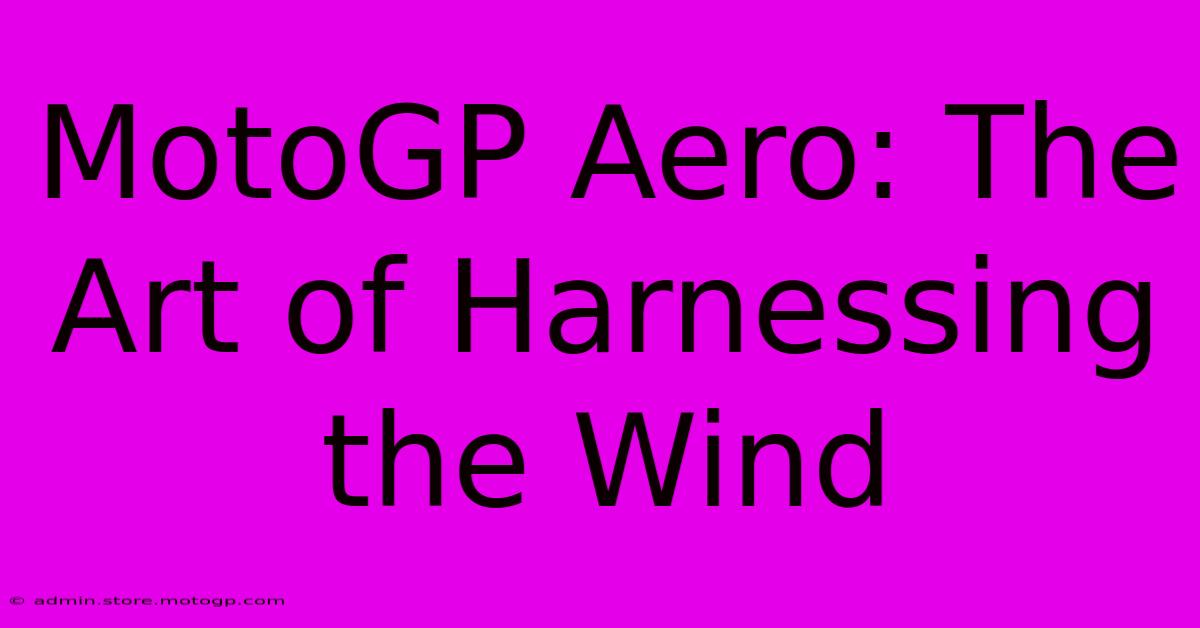MotoGP Aero: The Art Of Harnessing The Wind

Table of Contents
MotoGP Aero: The Art of Harnessing the Wind
MotoGP racing isn't just about raw horsepower; it's a delicate dance between rider skill and machine performance. A crucial element often overlooked by casual viewers is aerodynamics – the art of harnessing the wind. MotoGP aero isn't just about speed; it's about stability, braking, and ultimately, winning races. This article delves into the complex world of MotoGP aerodynamics, exploring its evolution and impact on the sport.
The Science of Speed: Understanding MotoGP Aerodynamics
At speeds exceeding 200 mph, aerodynamic forces become a dominant factor. The wind resistance, or drag, acts against the bike and rider, significantly impacting performance. MotoGP aero packages are meticulously designed to minimize this drag while simultaneously generating downforce.
What is Downforce and Why is it Important?
Downforce is the aerodynamic force that pushes the motorcycle towards the track surface. This increased grip is crucial for several reasons:
- Enhanced Cornering: Greater downforce allows riders to lean into corners more aggressively without losing traction, enabling faster lap times.
- Improved Braking: Increased grip from downforce provides superior braking performance, crucial for navigating tight corners and overtaking maneuvers.
- Stability at High Speeds: Downforce combats the destabilizing effects of high-speed airflow, improving the bike's overall stability and control.
The Evolution of MotoGP Aerodynamics
MotoGP aero has undergone a dramatic transformation over the years. Early bikes were relatively aerodynamically simple, but advancements in computational fluid dynamics (CFD) and wind tunnel testing have led to incredibly sophisticated designs.
From Simple Fairings to Complex Appendages
The evolution has seen a shift from basic fairings to complex appendages like winglets, wings, and aerodynamic surfaces strategically placed throughout the motorcycle. These components are not just aesthetic additions; they're meticulously engineered to generate specific amounts of downforce in different areas of the bike.
The Ongoing Arms Race: Technological Innovation
The constant pursuit of marginal gains fuels a fierce competition among manufacturers. Teams constantly refine their aero packages, experimenting with new designs and materials to gain a competitive edge. This continuous innovation ensures that MotoGP aerodynamics remain at the forefront of motorsport technology.
The Rider Factor: Human-Machine Interaction
While the technology is impressive, the human element remains critical. Riders must adapt their riding style to accommodate the changes in handling characteristics brought about by different aero packages. The feedback they provide to the engineering teams is invaluable in the ongoing development process.
Fine-Tuning for Optimal Performance
The interaction between rider and machine is a delicate balance. The engineers must find the optimal level of downforce that maximizes performance without making the bike too difficult to control. This constant calibration and refinement are a testament to the complexity of MotoGP aerodynamics.
The Future of MotoGP Aero: Sustainable Solutions and Technological Advancements
The future of MotoGP aero is likely to involve a continued focus on efficiency and sustainability. The search for lighter, more durable materials, as well as exploring more innovative designs, will continue to shape the sport.
Beyond Speed: The Pursuit of Efficiency
While speed remains paramount, the focus on sustainability is growing. Manufacturers are striving to create aero packages that are both efficient and environmentally friendly. This commitment will shape the future of the sport.
Conclusion: Mastering the Wind
MotoGP aerodynamics represent a fascinating blend of science, engineering, and human skill. The constant push for performance improvements makes it a captivating aspect of the sport, driving innovation and ensuring that MotoGP remains at the cutting edge of motorsport technology. The art of harnessing the wind is as crucial to success as the power of the engine itself. Understanding the intricate workings of MotoGP aero enhances the appreciation for the incredible feats of both rider and machine.

Thank you for visiting our website wich cover about MotoGP Aero: The Art Of Harnessing The Wind. We hope the information provided has been useful to you. Feel free to contact us if you have any questions or need further assistance. See you next time and dont miss to bookmark.
Featured Posts
-
Discover The Magic Of The American Road The Queen Circuit
Feb 18, 2025
-
The Legacy Of American Moto Gp Legends
Feb 18, 2025
-
The Future Of Moto2 2025 Standings Predictions
Feb 18, 2025
-
Grand Prix Red Bull A Symphony Of Speed And Skill
Feb 18, 2025
-
Unleash Your Inner Racer Moto Gp Motorcycle For Sale
Feb 18, 2025
